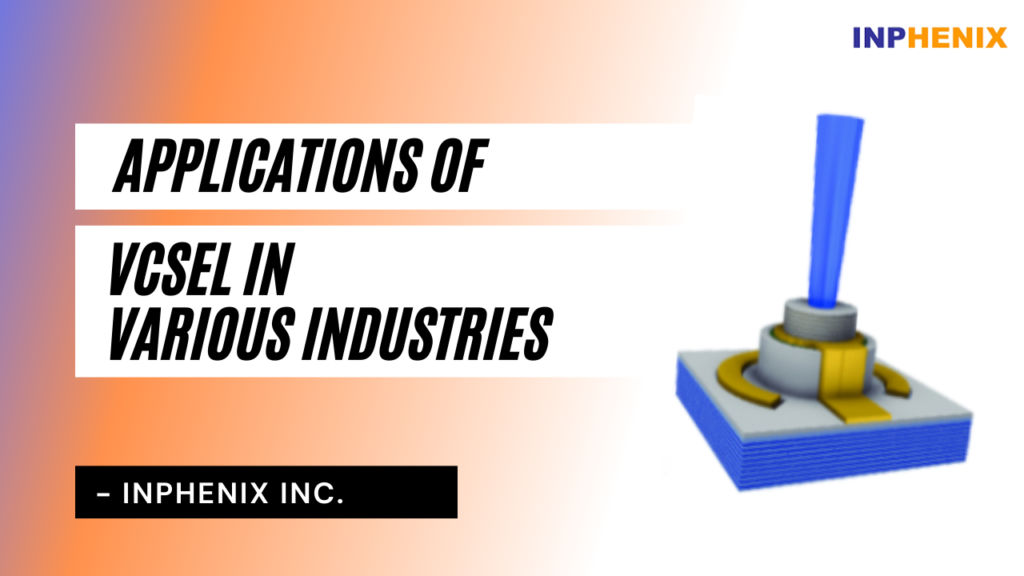
Vertical-cavity Surface-emitting Lasers, commonly known as VCSEL, have a wide range of applications. The laser can be fabricated in various ways, including on the surface or within arrays. The key distinction that distinguishes the VCSEL from other lasers is that it emits light from the top rather than the edges, as other lasers do.
This guarantees that the output power is optimum. Moreover, this is often in the shape of a circular beam of light which is highly compatible with modern optical instruments.
In this article, we will look at the applications of VCSEL light sources in various industries such as communication, sensors, and computing. Along with these three primary industries, this laser is also used in the manufacturing process of smart vehicles and smartphones.
If you are excited to know more about Vertical Cavity Surface Emitting Lasers then you can check our blog An Introduction to VCSEL.

VCSEL laser arrays and their low power consumption are used for novel applications by a number of smart manufacturing companies, including Apple and Samsung. One such application of VCSEL in smartphones is 3D sensing. LEDs has been used for 3D sensing for many years. The LED’s effectiveness, however, had several limitations.
Vertical Cavity Surface Emitting Lasers overcome these limitations by providing a very narrow linewidth. Moreover, because the light is infrared and non-intrusive, the process of producing 3D information is substantially faster. The results provided by this tunable VCSEL are so good that they cannot be achieved even with two cameras.
VCSELs, like other lasers, are used in optical communication technology. Their properties, such as a circular beam shape, a broad free-spectral range, and large and continuous tuning, make them ideal for optical communication. In addition, as compared to standard lasers, Vertical Cavity Surface Emitting Lasers can transfer data at a rate of 100 GB per second due to multiplexing.
Additionally, because communication technologies have a bright future and must advance, we will see a variety of VCSEL applications in this area, such as high-bandwidth Vertical Cavity Surface Emitting Lasers sources for future optical communication systems based on intensity modulation and/or sophisticated modulation formats.
In recent years, high-power VCSEL has emerged as a key technology for DMS (Driver Monitoring Systems) and OMS (Occupant Monitoring Systems). In addition, the technology is used for facial recognition, LiDAR, and gesture control, among other things.
The Near-Infrared (NIR) camera records the returning signals and calculates the total time it takes for the signals to reach the receiver from the emitter. This depth measurement enables 3D measurement of objects such as roads, cities, and gardens, as well as face measurement for facial recognition.
Another application for VCSELs is in smart automobiles. This laser is being tested and utilized in autonomous or driverless automobiles. The smart automobile sector considers VCSEL arrays to be the best in the market in terms of power density, conversion efficiency, and pitch. VCSELs can also distinguish in scan and flash applications and are less vulnerable to individual emitter failures.
The VCSEL-supported occupant monitoring systems (OMS) function as an enhanced kind of in-cabin, near-IR camera, allowing the vehicle to understand the positions, sizes, and actions of the driver and passengers. Although the use of VCSELs in level-3 automated driving systems is still in its infancy, we may expect more applications in the near future.
These are the four most common applications for Vertical Cavity Surface Emitting Lasers. Along with these, it can be used in commuting, integrated optics, and a variety of other applications. In the end, if you want to know about some special advantages of VCSEL, then you can check our blog: Top 6 Advantages of VCSEL
Inphenix is a light source manufacturer based in the United States that manufactures optical components such as swept-source lasers, distributed feedback lasers, gain chips, Fabry Perot lasers, and Vertical Cavity Surface Emitting Lasers. In addition, the company supplies customized components depending on the clients’ requirements. To learn more about our products, contact us.
